What Hi-Fi? Verdict
The most recognisable amplifier in the world? One of the most beautiful? It is also the quietest and has the lowest distortion of all. Yet the Eclipse Stereo is not one of the most expensive hi-fi amplifiers in the world – not even close.
Pros
- +
Sensational sound quality
- +
Quiet and low distortion
- +
Handsome appearance
Cons
- -
Size!
- -
Weight!
Why you can trust What Hi-Fi?
This review and test originally appeared in Australian Hi-Fi special edition Audio Esoterica magazine, one of What Hi-Fi?’s sister titles from Down Under. A full bench test was subsequently published by Australian Hi-Fi and is also included here. Click here for more information about Australian Hi-Fi, including links to buy individual digital editions and details on how to subscribe.
I don’t imagine many people would contradict me if I said that Halcro’s Eclipse power amplifier – in either its mono or stereo version – is the most immediately recognisable amplifier in the world. It is so recognisable that in a pitch-black room it can quickly and easily be identified by touch alone. The Halcro Eclipse is also – albeit this time arguably – the most beautiful amplifier in the world, which is undoubtedly one of the reasons it has featured on the front covers of so many hi-fi magazines around the world, including here in Australia.
The story behind the amplifier’s design is also one of the most interesting and unusual in audio. The intellect behind Halcro’s creation, and indeed the brand’s name, was South African physicist and engineer Dr Bruce Halcro Candy (you can see why he used his middle name!), who after founding the company and becoming world-famous for the very first amplifier he built (the Halcro dm58) was then head-hunted by Minelab, famous for its hand-held metal detectors, after which the company languished as no more than a listing in the Australian government’s official register of company names.
It languished on that list until one sunny Saturday morning, when Lance Hewitt, who had been Candy’s lead engineer, was adding to his collection of vinyl at a South Australian record store. The store’s owner, who knew that Hewitt had formerly worked for Halcro, introduced him to Mike Kirkham of Magenta Audio, an Australian audio equipment importer, retailer and distributor who also happened to be at the record store buying vinyl that very same morning. Hewitt told Kirkham not only that he had been personally responsible for building and testing Halcro amplifiers but also that he happened to know that all of the circuit diagrams, PCBs and tooling required to build them were gathering dust in a storage facility – indeed, one not far from where they were chatting.
The result of this serendipitous Saturday morning meet was that Halcro became resurrected as a going entity. Kirkham contacted Dr Peter Foster, a friend of his who holds a PhD in physics from the University of Adelaide and was formerly a Senior Laser Physicist at Norseld Pty Ltd and a Guest Scientist at the University of Bayreuth, Germany. The result was the trio founding a new company, Longwood Audio, which in 2015 acquired all of Halcro’s assets, including the brand name, the company’s portfolio of patents and the all-essential machine tooling along with a batch of unsold mothballed stock.
Foster is now Longwood Audio’s CEO; Kirkham is its Head of Sales and Marketing; and Hewitt is in charge of development and manufacturing.
Build & technology
The ‘look’ of the Eclipse Stereo is directly copied from the design of the original Halcro dm38, which was the work of Adelaide designers Tony Kearney and Max Dickison. Candy’s brief to them was that, to ensure the correct operation of the amplifier, the electronics had to be separated into four heavily shielded modules – an audio power module, an audio drive module, an inductor module and a power supply module – and that, in order to remove the heat passively without using fans, the heatsinks for the output devices had to be extraordinarily large.
Those very design elements have been incorporated in the Eclipse Stereo. One important change, however, has been in the execution of the heatsink design. the original’s design was microphonic so that at certain frequencies it could vibrate so significantly that its resonances were audible in the listening room. The heatsinks on the Eclipse Stereo, however, are non-resonant by virtue of being completely redesigned. The new design sees each section fabricated from up to 10mm-thick folded aluminium, with the winged sections fully damped and the joins connecting the horizontal chambers to the wing sections. The non-wooden sections of the chassis now come in either a ‘Standard’ powder-coat finish or a premium hand-painted ‘Signature’ finish, too.
If you are at all familiar with Halcro amplifiers, you will already have an inkling of how large the Eclipse Stereo’s chassis is; if you’re not, let me point out that a person of average height, when standing upright, will not need to lean down to touch one of the amplifier’s vertical wings. Checking out the amplifier’s proportions in the images accompanying this review should also give you an idea of how wide the amplifier is, but just to make it perfectly clear, the Halcro Eclipse Stereo power amplifier is not only 79cm tall but also as wide as it is deep (40cm).
It’s not lightweight either, tipping the scales at 62kg. (And, when eyeing the images, don’t miss the fact that the shape of the chassis actually forms the capital letter ‘H’, which is pretty clever!)
The internal circuitry of the Halcro Eclipse Stereo inherits DNA from the original Halcro dm38, as well as from the Eclipse Mono, but according to Hewitt, while some things have been lost (such as the current mode inputs), many other aspects of the circuitry have been improved – some are the natural result of improvements in technology, some are the result of improvements in circuit layouts, and some are the result of research and development by Longwood Audio itself, for which Hewitt says the company has been awarded four patents.
Candy was always secretive about the circuitry of the Halcro dm38, and Longwood Audio is continuing this tradition. CEO Peter Foster told Paul Miller of Hi-Fi News & Record Review: “We never release schematics [and] every circuit has the component designators engraved off and the boards are coated in an epoxy layer to further mask what’s going on”.
Miller says he was nonetheless able to glean the following information about the Eclipse Stereo: “The power supply is a two-stage switch-mode design with power factor correction. The first switch-mode power supply buffers the amplifier from the AC mains by generating a very high DC voltage from which the second power supply delivers the rail voltages for the power amplifier, [and] although the building blocks of the amplifier are conventional – a differential voltage-to-current input stage, current mirror, voltage line/preamp stage and, crucially, a unity-gain power output stage employing 12 (V)FETs – the way they are implemented, all on six-layer PCBs, is where the proprietary thinking resides.”
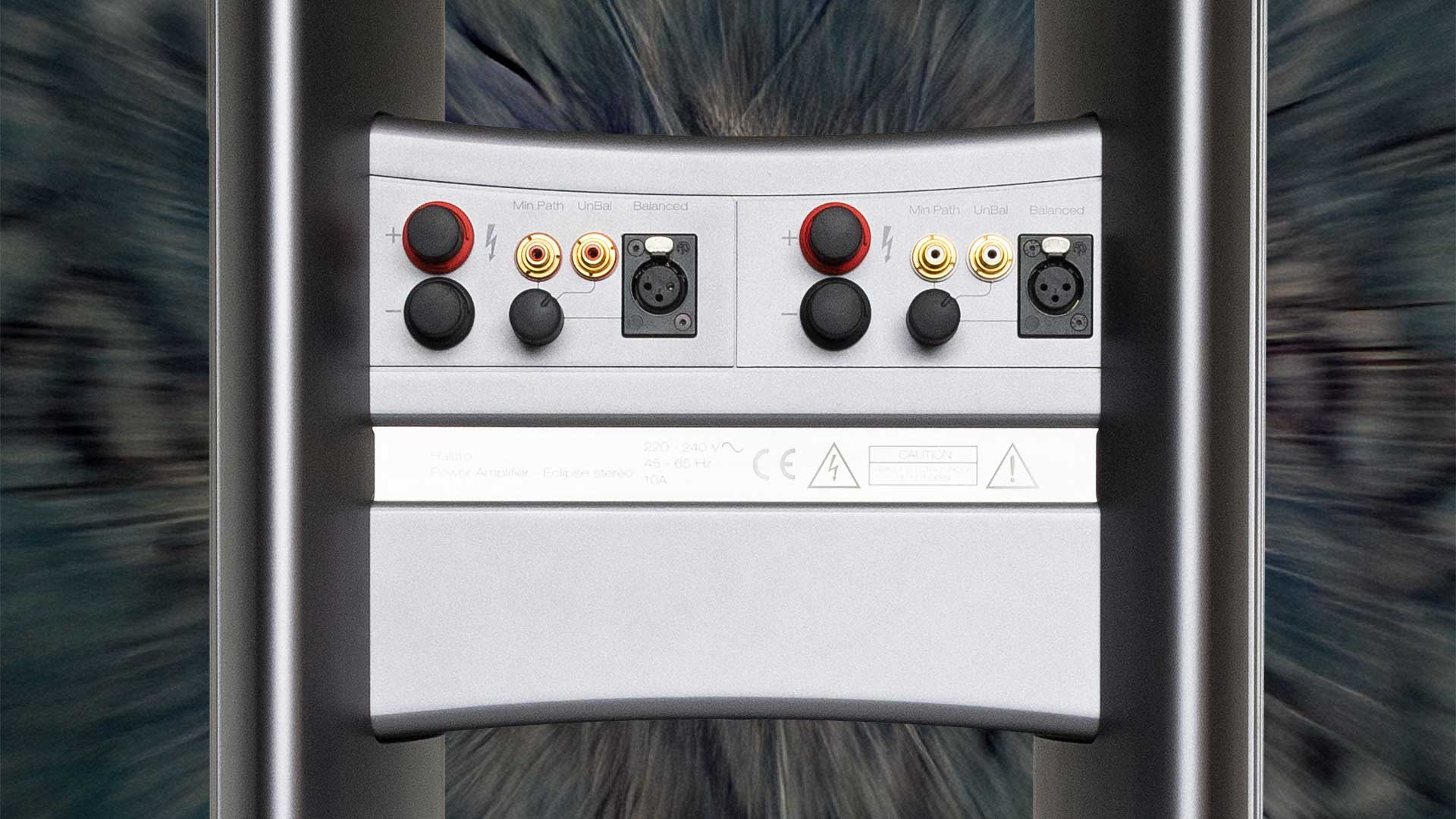
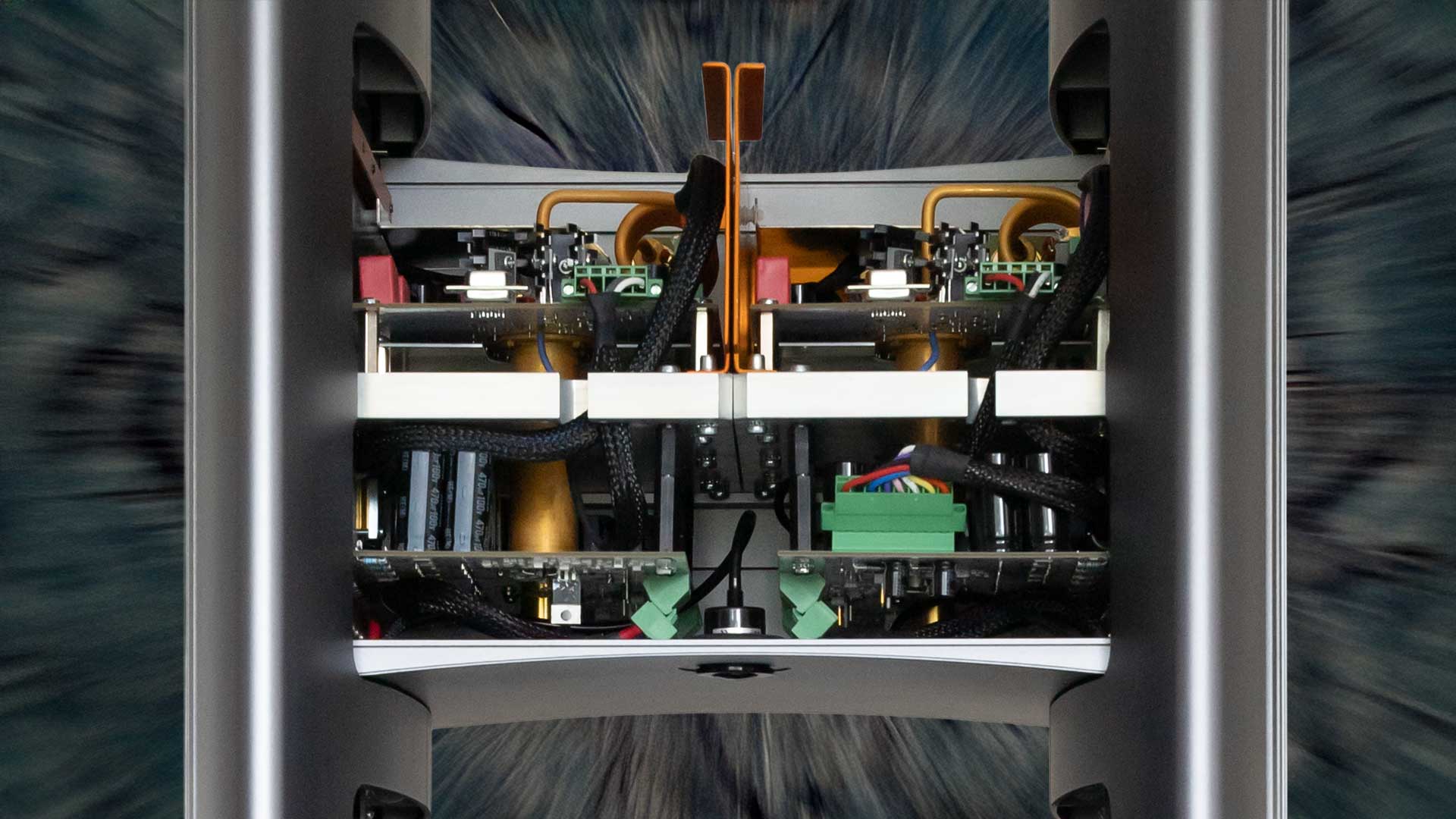
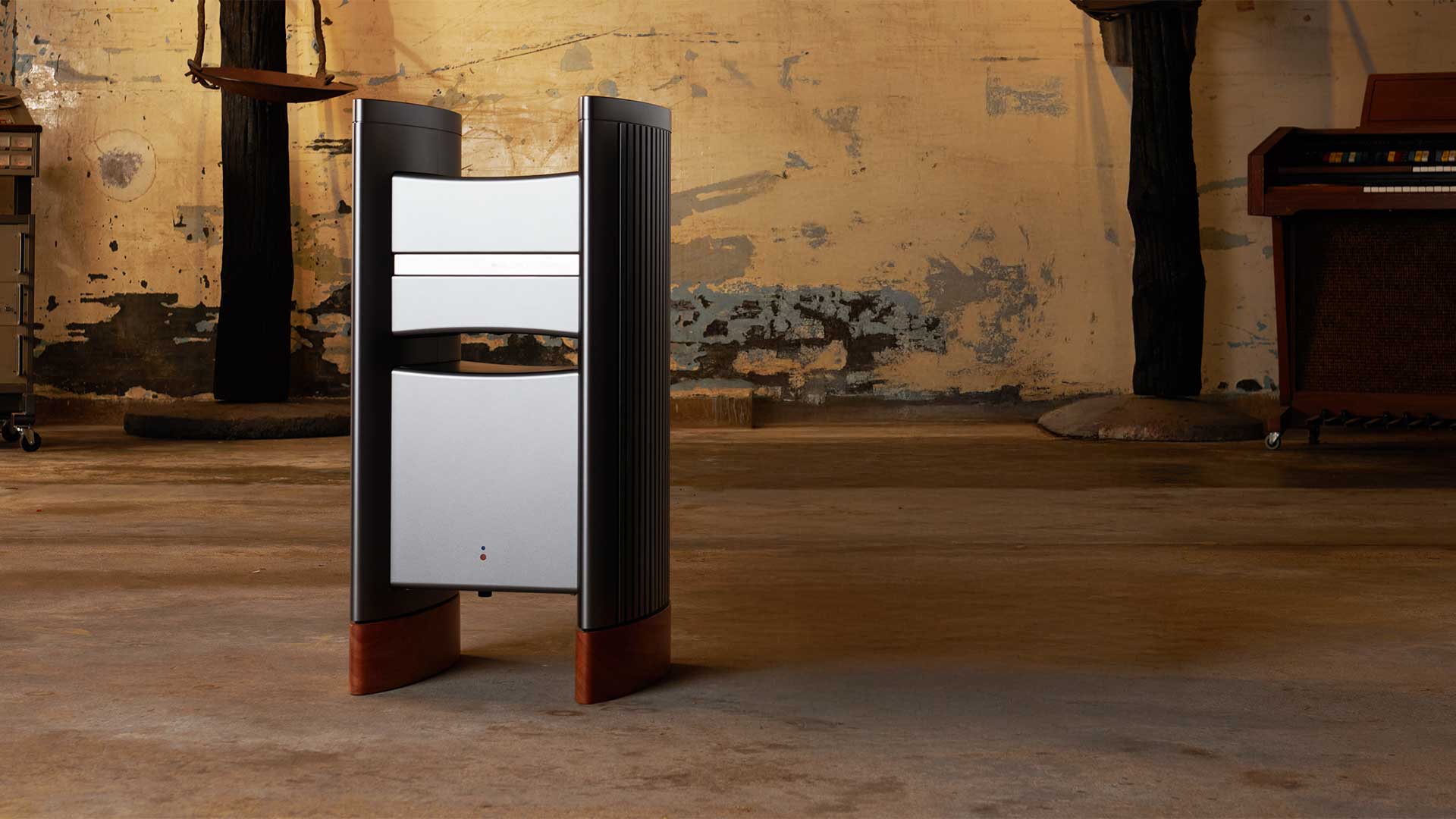
Power Output (4Ω): >350 watts per channel (1kHz)
Power Output (8Ω): >180 watts per channel (1kHz)
Frequency Response (–3dB): 3Hz–215kHz
Frequency Response (–1dB): 7Hz–90kHz
Noise: 5nV/sqrt(Hz) (Equivalent Input Noise)
THD: <–120dB (20Hz–20kHz)
THD @ 1kHz: <–134dB
IMD: <–120dB (SMPTE & TT)
Slew Rate: 100V/µS
Overload Recovery: <1mS
Dimensions (HWD): 79×40×40cm
Weight: 85kg
See also Laboratory Report below
Further details of how the circuit might work are revealed in US Patent 6,600,367, which was granted to Candy and is currently assigned to Longwood Audio:
"An electronic amplifier providing very low distortion which includes an output stage with an output error correction stage containing two amplifiers and wherein there are at least four local negative feedback paths, an output of the first amplifier being connected to an input of output stage transistor buffers or output stage transistors through a first network, an output of the second amplifier being connected to an input of output stage transistor buffers or output stage transistors through a second network, where components of the first and second amplifier the local negative feedback paths, first and second networks and output stage transistor buffers are selected to form substantially second order local dominant pole. Also disclosed is the supply of power to said first and second amplifiers from a floating power supply means coupled to either an or the output of the output stage so that the voltage of the floating power supply will follow substantially an output voltage of the output stage."
Also interesting are some of the patent’s citations, which reference an active bias circuit for operating push-pull amplifiers in Class A mode (granted to one Nelson Pass), a distortion-free complemented error feedback amplifier method (granted to James Strickland), and reducing amplifier distortion by comparison of input and feedback from output (granted to Barry Elliot Porter). The patent also directly cites one Douglas H. Self. (For readers who are unfamiliar with these names, any audio engineer asked to name the world’s top five audio amplifier designers of the last 50 years would include three of those names.)
Input and output connections are made on the module at the top of the amplifier, at the rear. The Eclipse Stereo has both unbalanced (via gold-plated RCA) and balanced (via gold-plated XLR) inputs, plus a ‘low gain’ unbalanced input. The speaker cable terminals are absolutely huge, and while they’re supposed to be combination spade/banana types, the only way I could see to use banana plugs was to remove the rubberised cap on the knob – but I wasn’t prepared to risk damaging it trying to pry it off!
Halcro has built several sophisticated automated protection systems into the Eclipse Stereo to prevent it from being damaged by a variety of issues that could impact its performance, covering everything from power supply stability to problems that could affect the output stages.
Longwood Audio says that the Halcro Eclipse Stereo amplifier “is short-circuit proof, has over-current limiting, has gradual power limiting if the amplifier becomes too hot, will cut out if a continuous DC offset appears on its output, will cut out if output current exceeds 12 amperes average continuously over a period of a few minutes, is protected against most input overloads, has power supply protection that will cut out if faults are detected in the power supply (such as over-voltage, master clock at incorrect frequency, excessive temperatures), and is protected against most mains transients”.
Even the standby switch is air-pressure activated rather than a traditional electrical switch, to minimise interference.
It’s good that there’s such a high level of overkill on the protection front, because the company’s secrecy about its circuits, including the values of the components used in those circuits, would mean that any fault could only be addressed by a technician with insider knowledge. Otherwise, the amplifier would need to be returned to South Australia – and given its size and weight, that would be rather an expensive exercise!
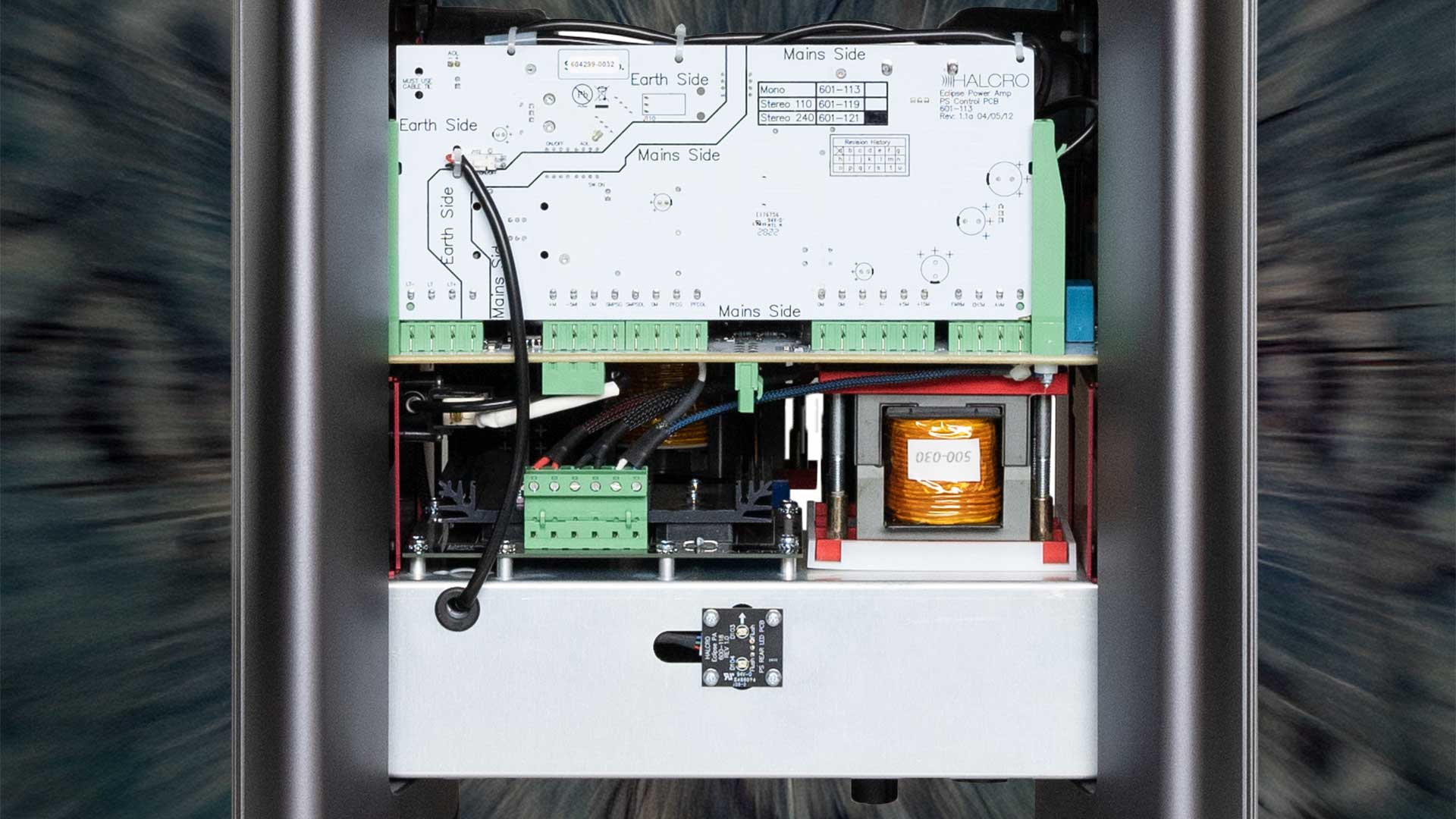
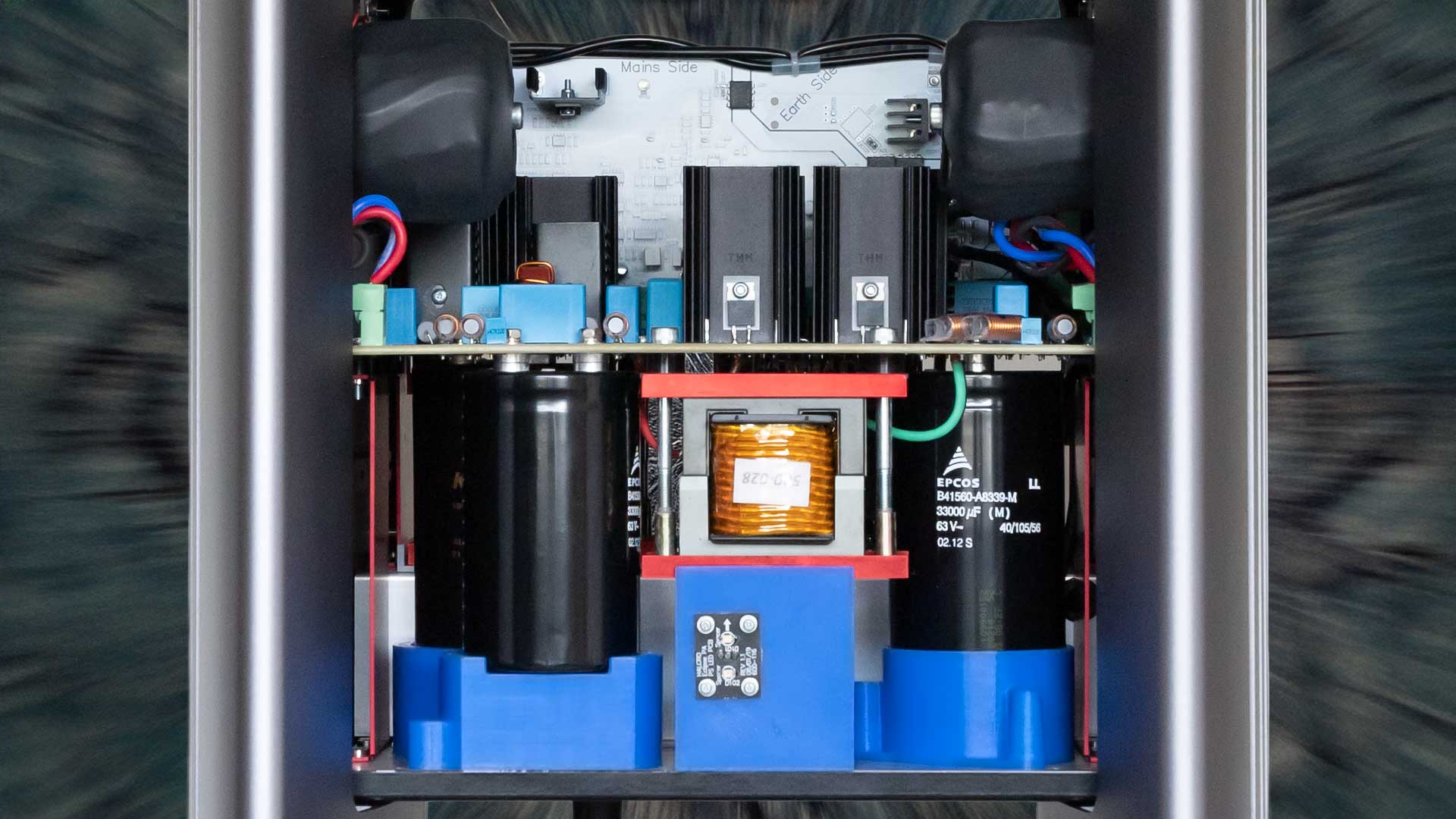
Listening sessions
My first audio experience of the Halcro Eclipse Stereo during testing was by way of an initial warm-up using music from a band with which I have a love/hate relationship: GoGo Penguin. Delivering amazing sound for what is essentially just a trio (percussion, bass and keys), the band’s music has been described as a form of jazz for the modern age – but then again, is it? I love the sound but hate not being able to define exactly why it’s so mesmerisingly great, and find the group hard to recommend to others because their music is so polarising.
What I can say with certainty is that it really helps if you are listening to their music through an amplifier with the high performance of the Eclipse Stereo. For example, the double-bass on Raven (from the album ‘A Humdrum Star’) is not only beautifully captured in terms of sounding just like a double-bass should, but it’s also just a lovely bass line – so inventive that you really can’t foretell the next note, as you can with performances by many lesser bassists. In delivering this line so well, Nick Blacka provides a unique counterpoint to Chris Illingworth’s gloriously grand pianism, even though you can sometimes foretell what note Illingworth is going to play next because he plays so many that are the same! The complexity of the sound is jaw-dropping, and the scattergun drumming of Rob Turner (who’s since been replaced by Jon Scott) is epic, and beautifully delivered by the Halcro.
On Bardo, the following track, you’ll hear Blacka’s double-bass sounding like nothing you’ve ever heard before, as he delivers miraculous high-frequency overtones that make a mockery of the instrument’s normally accepted frequency range. The Eclipse Stereo delivers the entire gamut perfectly – the delivery is sonically contiguous, despite the rarity of the nature of the sound. When the drum kit comes in, at about 1:30, the accuracy with which the amplifier delivers the kick drum sound in exact syncopation with the high-hat strikes, all while keeping each in its own sonic envelope, and with no unwanted overhang, is an object lesson in the importance of state-of-the-art amplification in an audio reproduction chain. The Halcro Eclipse also maintained the ‘airiness’ of the acoustic as a constant throughout – a subtlety that eludes lesser amplifiers.
The buzzy, insect-like opening to One Hundred Moons highlighted for me the complete lack of background noise from the Eclipse Stereo’s circuitry – the amplifier makes no noise at all other than what is actually in the audio signal delivered to it. There is no low-frequency hum, no high-frequency hiss, and absolutely no modulation of the lowest-level background sounds on a track. Such sounds issue from an inky-black silence that is so silent it’s almost mesmerising in and of itself. The simplicity of the percussion and piano on this track is a musical antidote to what has gone before, and the crystalline clarity of the sound I heard from the Eclipse Stereo was simply amazing, a testament to the complete lack of audible distortion.
I do need to warn you that I think GoGo Penguin has gone somewhat off-piste with their latest album, ‘Everything Is Going To Be OK’ – both sonically and musically – so if you want to hear what I heard, I recommend sticking with the four albums the band recorded with Blue Note, which include ‘Man Made Object’ and the aforementioned ‘A Humdrum Star’.
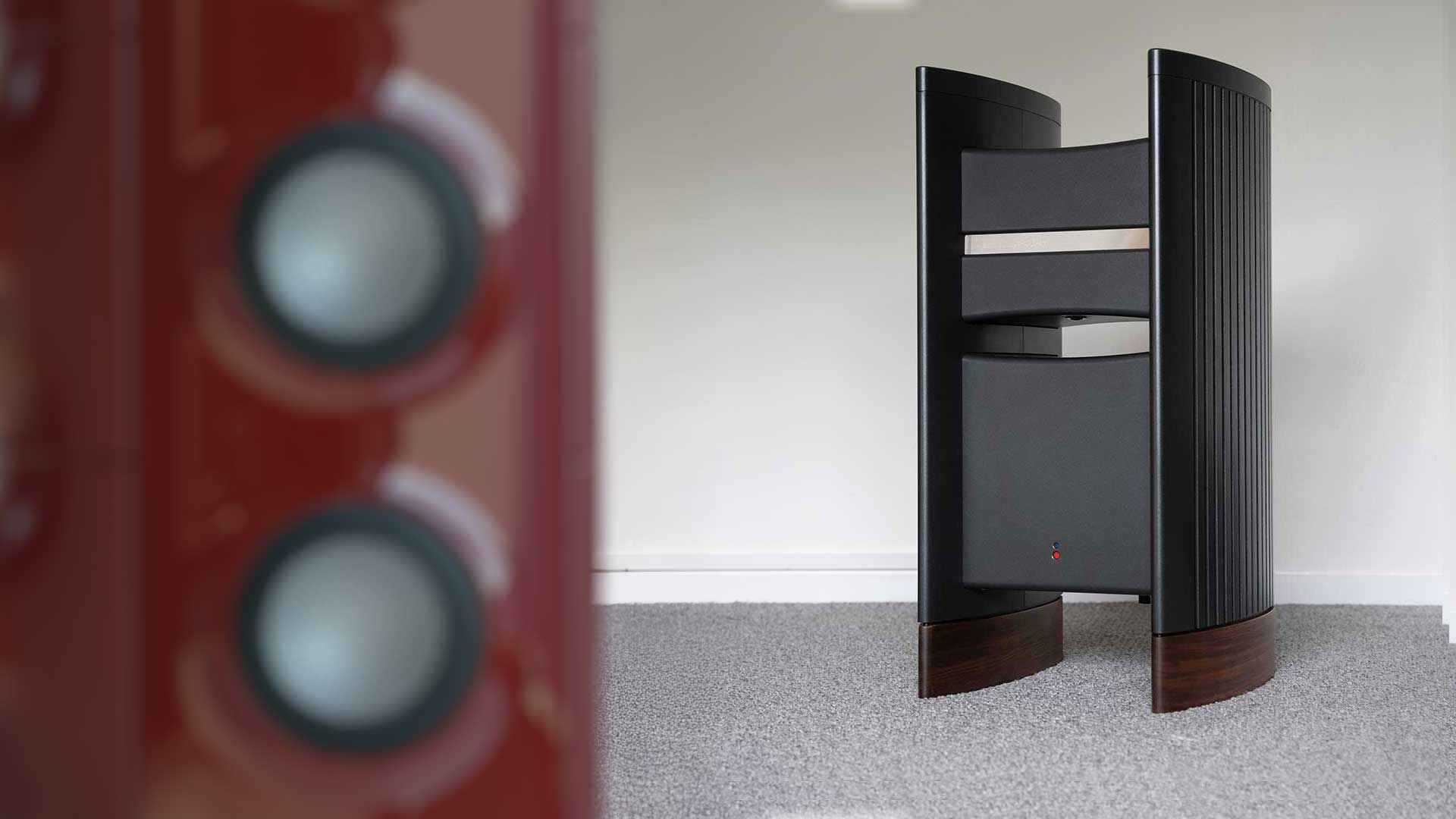
If you’d rather test out the Halcro Eclipse Stereo’s enormous power reserves and bass delivery with music that’s not so ‘out there’, I recommend revisiting – or listening to for the first time! – Talking Heads’ 1983 classic album ‘Speaking In Tongues.’ The funky bass sound is deep and tight, and Chris Frantz’s drum, beautifully captured on this recording, sounds as real as can be. Obviously, you’d listen to opener Burning Down The House at a high volume, but you should also crank up the dial while listening to Girlfriend Is Better in order to hear how well the Eclipse Stereo can deliver the eclectic and varied synthesizer sounds on this track at any volume level you care to listen at. Listen, too, to how well the left and right channels are separated. Indeed channel separation is so complete that I could easily have been convinced that I was auditioning a pair of Eclipse Monos instead!
You can hear not only the channel separation but also the beautiful stereo imaging of the Eclipse Stereo on This Must Be The Place where the vocals are trademark Talking Heads timbre and the purity of the percussion sound is exemplary, particularly the ‘found instrument’ sounds delivered by David Van Tieghem. I had lots of fun working out the various ‘found instruments’ he was playing.
I have often written in the pages of Australian Hi-Fi magazine that the piano is the best instrument with which to evaluate audio components due to its enormous pitch compass, supreme dynamics and the fact that it’s a stringed percussive instrument, and you could have no better music to hear all of this than that on French pianist Alexandre Tharaud’s 2009 recording of more than 70 works by Erik Satie. This, of course, includes the famous Gnossiennes, but here they are strangely interwoven with other lesser-known works, in such a way that it’s as if you’re hearing them for the first time.
Indeed some of these works you may actually be hearing for the first time, because it was Satie, not John Cage, who invented the ‘prepared piano’, and unlike many pianists, Tharaud follows Satie’s instructions to the letter in Le Piège de Méduse by placing sheets of paper on the upper octave strings. I can’t say I liked the result, but the Eclipse Stereo certainly reproduced it faithfully. Elsewhere on this recording, Tharaud’s playful execution of Satie’s more conventional scores is certainly more entertaining than the performances delivered by more sedate pianists.
Verdict
The Halcro Eclipse Stereo is not only the most recognisable amplifier in the world, along with being one of the most beautiful, but it is also the quietest and has the lowest distortion of all.
If you think that is part and parcel of what makes it one of the best-sounding amplifiers in the world, I’m not about to disagree. You may, however, be surprised to learn that the Eclipse Stereo is not one of the most expensive hi-fi amplifiers in the world. In fact, it’s not even close – dozens of its competitors have price tags in excess of $150,000!
In light of this information, you should realise that the Halcro Eclipse Stereo could be considered good value even at twice its price.
Laboratory Test Report
Readers interested in a full technical appraisal of the performance of the Halcro Eclipse Stereo Power Amplifier should continue on and read the LABORATORY REPORT published below. Readers should note that the results mentioned in the report, tabulated in performance charts and/or displayed using graphs and/or photographs should be construed as applying only to the specific sample tested: Steve Holding, Newport Test Labs.
Halcro rates the per-channel power output of the Eclipse Stereo as 180 watts into eight ohms and 350 watts into four ohms. With the Eclipse Stereo on its test bench, Newport Test Labs measured the 1kHz power output at 202 and 386 watts per channel into eight and four ohms respectively, so the power amplifier bettered its specification for both test loads.
As you can see from the tabulated results, power output dropped to 196 watts into eight ohms when the test frequency was dropped down to 20Hz (when driving two channels), and to 365 watts when both channels were driven into four ohms at this same 20Hz frequency. While these are lower than the 1kHz power output results, they’re still comfortably higher than Halcro’s specification.
Newport Test Labs measured the frequency response of the Eclipse Stereo as being 3dB down at 3.5Hz and 280kHz, so this is a very wide-band amplifier design. It’s also a superbly linear one, as evidenced by the 1dB down-points of 6.5Hz and 90kHz, meaning the normalised frequency response is 6.5Hz – 90kHz ±0.5dB.
As you would expect, the frequency response was even flatter across the audio band. This response (Graph 1 above) shows that it’s around 0.1dB down at 20Hz and 20kHz, for a normalised response of 20Hz – 20kHz ±0.05dB. This frequency response was, as per industry standards, measured when the Eclipse Stereo was driving an eight-ohm test resistor. On this graph you would normally expect to find a second trace showing the amplifier’s response when driving a more complex load, one that simulates the load that a loudspeaker would present. In fact, that trace is there – you just can’t see it because it perfectly overlays the response into a resistor. This is the first time Newport Test Labs has ever measured this theoretically ‘perfect’ result!
Separation between the two stereo channels was outstandingly good, as you can see from the accompanying result table – 86dB at 20Hz, 101dB at 1kHz, and 78dB at 20kHz.
Also outstandingly good was the level matching of the two channels, with Newport Test Labs measuring a difference of just 0.01dB. Inter-channel phase accuracy was also exceptionally good, with errors of only 0.02° at 20Hz, 0.08° at 1kHz and 1.17° at 20kHz. The result at 20kHz may seem to be an outlier, but you should bear in mind that a result of 1.0° at this frequency would be a world-beating achievement.

Measuring the level of distortion on an audio signal that is introduced by a Halcro amplifier is a near-impossible task because it is so low that it is supremely difficult to measure. You not only need a test instrument capable of making the measurement but also a signal generator that has lower distortion than both the amplifier and the test instrument.
To illustrate the difficulty, look at Graph 2 above, which shows the distortion components inherent in the output of Newport Test Labs’ best signal generator. You can see that there’s a second harmonic distortion component at –117dB (0.00014%), a third HD component at –122dB (0.00007%) and a fifth at –128dB (0.00003%). So if we used this generator to provide the signal to measure the Eclipse Stereo’s distortion and saw a result that exhibited these same distortion components, at around the same levels, we would know only that the Halcro was not adding unwanted distortion.
Indeed this is exactly what we see in Graph 3, which shows the output spectrum of the Eclipse Stereo when it’s delivering this same 1kHz signal but amplified to a level of one watt into eight ohms. Essentially, the only difference is that the amplifier has added just a little distortion at 3kHz, so that it is at –120dB instead of –122dB. (The result was exactly the same when the Eclipse Stereo was driving a four-ohm load.)
The other thing to note with Graph 3 (because it will be significant later) is that there is some noise visible at the bottom of the graph, however as you can see from the scale at the left, the noise is 140dB below the one-watt reference level, which is so low that it would be totally and completely inaudible under any conditions.

Graph 4 shows distortion (and noise!) levels measured by Newport Test Labs when the Halcro Eclipse Stereo was delivering 1kHz into eight ohms at a power level of 20 watts.
Again, you can see that the distortion ‘signature’ is essentially that of the test signal generator, so the Eclipse Stereo is not adding any distortion to the test signal itself. Note, too, that there is now no audio band noise visible on the graph, so the Halcro’s audio band noise is now well below 140dB. There is some noise visible (the single narrow peak at the extreme left of the graph), which is from the amplifier’s power supply, but it’s more than 120dB down. Again, the result when the Eclipse Stereo was tested into a four-ohm load at this frequency and power output was exactly the same as it was into the eight-ohm load.

Graph 5 shows an extreme test case for distortion, which here is shown when the Eclipse Stereo is delivering 1kHz into an eight-ohm load at its full rated power (180 watts).
The result is mind-bogglingly (and I mean that in its truest sense) good. As you would expect, there is absolutely zero noise in the output other than that tiny leakage from the power supply, and the distortion levels are almost unchanged from that shown in the one-watt and 20-watt graphs. The level of the third harmonic has risen slightly so that distortion component is now sitting at –117dB, which is 0.00014%. The fifth-order component has also risen by 1dB to –127dB (0.00004%).
The result of Newport Test Labs’ testing aligns with Halcro’s claims that the Eclipse Stereo’s THD levels are “better than –120dB”, a lever that it points out is “lower than 1000 parts per billion”. The distortion result shown in the accompanying test result table tells the THD story in an easily understandable numeric form: 0.00006%.
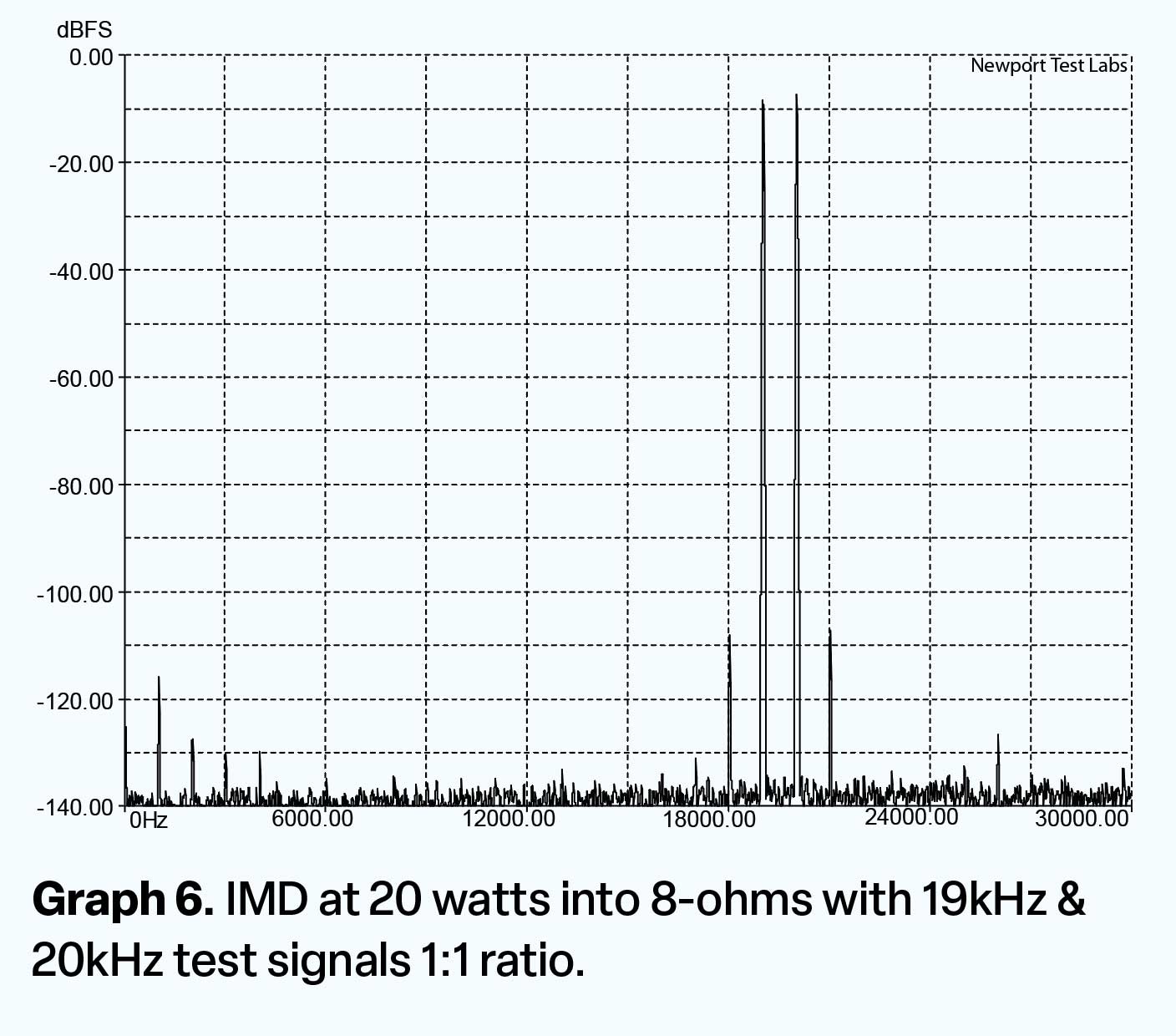
The level of intermodulation distortion (CCIF-IMD) measured by Newport Test Labs is shown in Graph 6 above, when the Eclipse Stereo was delivering twin 19kHz and 20kHz test signals at a level of 20 watts into eight ohms. There are only two high-frequency sidebands, at 18kHz and 21kHz, that are each 110dB down and so would contribute 0.0003% to the output – insignificantly small. There is a tiny regenerated signal down at 1kHz too, but it is also insignificantly small – 117dB down, contributing only 0.00014%. All other signals are more than 120dB down, which is the level specified by Halcro for this particular test.
The overall wide-band signal-to-noise ratios measured by Newport Test Labs were, as we’re sure you’ve already guessed from the noise floors shown in the graphs, spectacularly low. Noise relative to an output level of one watt was measured at –101dB unweighted, and –107dB A-weighted. We can’t think of a single amplifier the lab has measured that has ever come within cooee of returning a noise figure better than 100dB when referenced to this power level. The noise figures were better again for the measurement at rated output, with the Halcro returning results of –124dB unweighted, and –130dB A-weighted.
As one who is ‘experienced in the art’ would expect from Graph 1, the output impedance of the Eclipse Stereo was incredibly low, with Newport Test Labs measuring it as 0.002 ohms at 1kHz, which is an order of magnitude better than almost all other amplifiers and means a damping factor of 4,000!
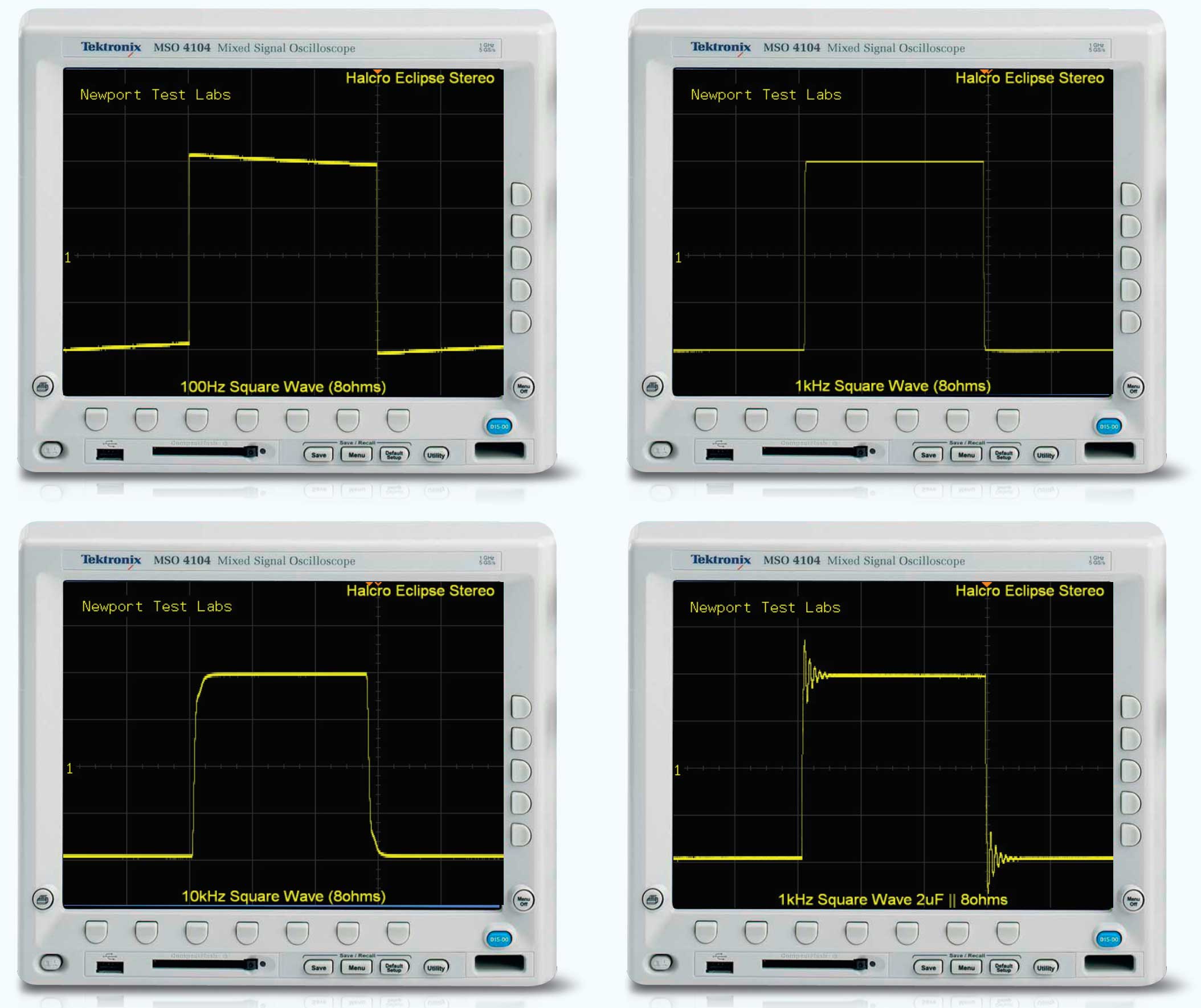
Square wave testing reflected the results returned when measuring the Eclipse Stereo’s frequency response, with the tilt on the 100Hz square wave reflecting the –3dB point of 3.5Hz (Halcro specs it at 3Hz). There’s no bending so there’s no low-frequency phase shift. The waveform at 1kHz is so squared-off and clean that it may as well have been issued directly from the lab’s function generator, and is therefore a perfect result.
At a 10kHz test frequency there is some rounding evident on the leading edge of the waveform, reflecting the high-frequency 3dB down-point of 280kHz, but the overall rise time shows a very, very fast slew rate.
The Eclipse Stereo’s ability to drive extremely demanding loudspeakers, as well as electrostatic designs, is shown by its performance when delivering a 1kHz square wave into an eight-ohm resistor paralleled with a 2µF capacitor. That performance was outstandingly good, with the initial overshoot being less than one-quarter wave height, and the small amount of resultant ringing being damped within five cycles. This amplifier will be completely stable into any loudspeaker.
We rather hope that this test report gives the average non-technical reader an appreciation of just how well this amplifier performed on Newport Test Labs’ test bench, but we suspect that ultimately it will be only those readers with a degree in electrical engineering who will truly appreciate the outstandingly high levels of performance delivered by Halcro’s Eclipse Stereo. It is a truly mind-bogglingly good amplifier!

